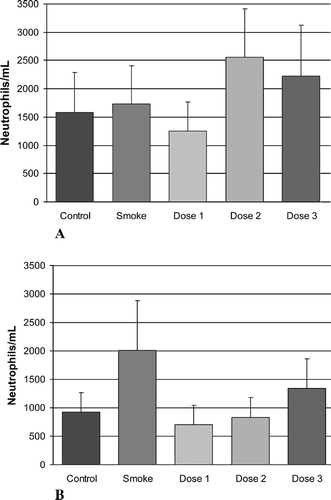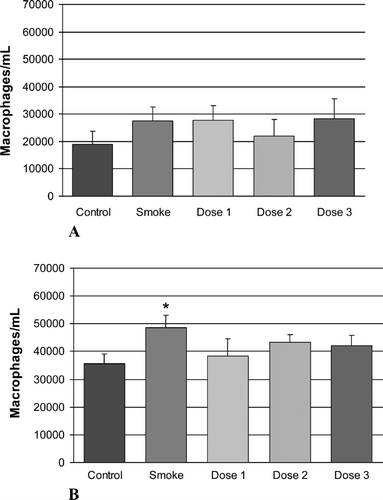Figures & data
Figure 1. The effects of cigarette smoke and inhaled rAAT on lavage neutrophils. Time points are (A) 1 week and (B) 6 months. The groups included control animals, age-matched cigarette smoke-treated animals (Smoke) and three groups of animals that received both smoke exposure and inhaled rAAT at three dose levels; see “Materials and Methods.” There was an increase in lavage neutrophils in the smoking group at 6 months when compared with control animals, and a reduction in neutrophil levels in the inhaled rAAT Dose 1 and Dose 2 groups when compared with smoking, untreated animals. These levels, however, did not reach statistical significance.

Figure 2. The effects of cigarette smoke and inhaled rAAT on lavage macrophages. Time points are (A) 1 week and (B) 6 months. The groups included control animals, age-matched, cigarette smoke-treated animals (Smoke) and three groups of animals that received both smoke exposure and inhaled rAAT at three dose levels, see “Materials and Methods.” There was a significant increase (marked with one asterisk) in lavage macrophages in the smoking group at the 6-month time point when compared with control animals. At 6 months, there was a reduction in lavage macrophages in all three dose groups when compared with smoke-treated animals, but this did not reach statistical significance.

Figure 3. LTB4 measurements at the 6-month time point show a statistically significant increase in levels of this inflammatory marker in the lavage fluids of the smoke-treated group. Reduced levels of LTB4were observed in all rAAT-treated groups, but this reduction did not reach statistical significance.

Figure 4. Airspace enlargement in response to cigarette smoke exposure and rAAT treatment. Smoke-treated mice (Smoke) have significantly increased emphysema (p < 0.01, marked with two asterisks) when compared with age-matched non-smoke-exposed control mice (Control). rAAT-treated mice exhibited significantly less airspace enlargement in Dose 1 and Dose 2 groups (71% and 73% respectively, p < 0.01 vs. smoke-treated, marked with two asterisks). In the Dose 3 group there was a lower level of protection by rAAT (42%, p = 0.1 vs. smoke-treated) against the effects of chronic cigarette smoke administration, see Results.

Figure 5. Human rAAT-neutralizing antibodies are generated by the inhaled protein. Murine IgG antibodies were purified from each group of animals and were used to inhibit the activity of rAAT against PPE in a microtiter plate assay. Pooled sera from animals that were not treated with rAAT (Control, Smoke) exhibited little or no rAAT-neutralizing activity. Under the conditions tested in this study (see “Materials and Methods”), purified IgG antibodies from the pooled sera of mice from the smoking groups that were treated with rAAT, inhibited rAAT's activity against PPE in a dose-dependent manner. Each data point was derived from triplicate assays with the 0% point defined as rAAT inhibition alone with no antibody, and the 100% point defined as PPE alone with no rAAT and no antibody. As a further positive control for rAAT-neutralization, purified commercially available anti-plasma AAT rabbit IgG was shown to be capable of inhibiting rAAT's activity quantitatively (data not shown).

Figure 6. Schematic representation of the proposed role for rAAT in interrupting the protease/protease inhibitor imbalance and resulting inflammatory cascade provoked by cigarette smoke. First and foremost, rAAT inhibits directly the degradation of elastin by NE. Further protection against matrix degradation may occur through lowering of both neutrophil and macrophage recruitment by reducing the production of chemotactic matrix breakdown products such as elastin-derived peptides (Citation[12]), and by protection of the endogenous tissue inhibitors of metalloproteases (TIMPs) against degradation by NE.
![Figure 6. Schematic representation of the proposed role for rAAT in interrupting the protease/protease inhibitor imbalance and resulting inflammatory cascade provoked by cigarette smoke. First and foremost, rAAT inhibits directly the degradation of elastin by NE. Further protection against matrix degradation may occur through lowering of both neutrophil and macrophage recruitment by reducing the production of chemotactic matrix breakdown products such as elastin-derived peptides (Citation[12]), and by protection of the endogenous tissue inhibitors of metalloproteases (TIMPs) against degradation by NE.](/cms/asset/805ebe14-12bf-4ba4-83f2-437a8b367bf4/icop_a_165098_uf0006_b.gif)